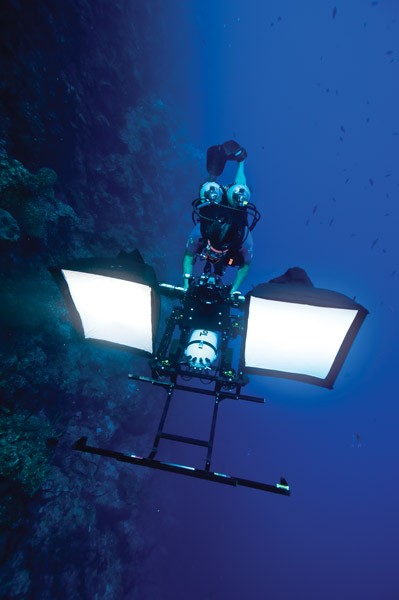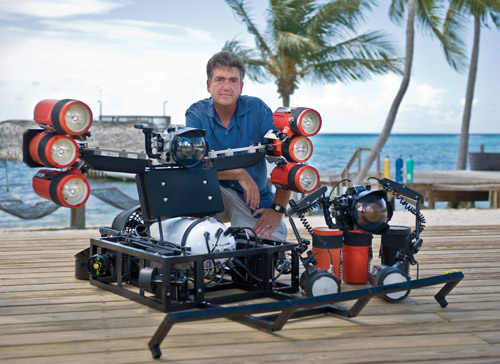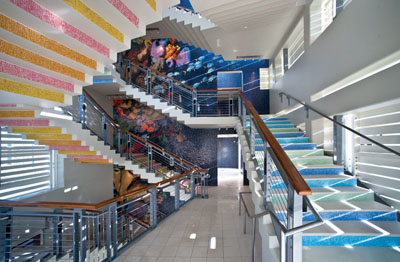Getting the BIG Picture
Wall diving in the Cayman Islands is extraordinary, even before you hit the water
Text by Peter Golding

There’s a wall dive you won’t want to miss next time you’re in the Caymans. Any vacationer to these islands can enjoy this particular reefscape ascending a double helix staircase more than 75 vertical feet (21m) in the Camana Bay observation tower on Grand Cayman. The artistic celebration of the surrounding sea you encounter inside this building is a showcase of all that you’d expect to see on a dive around any one of the three islands because that’s how it was imagined, designed and crafted. Indeed, it’s a storied art installation literally and figuratively that’s best appreciated when you get the big picture.
And for that we went to Jim Hellemn. Without question he’s your go to guy for the big picture on this, and any other large scale underwater image making for that matter. His photographs are as big as the ocean itself, yet remarkably detailed, which is unusual. His painstaking process using a sophisticated custom-built imaging system, and many helping hands, result in life size vistas of the marine realm that elicit lavish response for what they represent at the crossroads of art, science and technology.
To ask, ‘how the heck did he do that’, is a good place to start. For Hellemn, a photo fanatic since childhood whose commercial photography business involved producing ‘big’ trade show displays, the answer, unlike the work itself, is not complicated. “I was working on a complex composite image one day and it dawned on me that I could probably do this underwater,” he recalls. “As I started to work it out in my head I realized that I already had a lot of the equipment and skills I’d need.”
That moment of clarity marked the beginning of a new career direction for the Oregon native whose diving life began in 1986, the mid point of the previous decade when his product photography and other commercial work increasingly had taken a back seat to his interest in ocean engineering, especially as it concerned imaging technology. Working for Maxwell Technologies he was immersed in advanced technology ventures developing high energy laser systems to railguns. He explored new techniques using X-ray cameras to ‘stop’ bullets in flight and measure their speed, for example. In the early ‘90s, at Spectrum Engineering and Westinghouse, he helped develop a new underwater laser scanning system that for several years he operated on underwater search and survey missions and in support of oceanographic research projects.

‘Magical Things’
In 1994 he started his own enterprise, Photographix, when digital imaging was new. Interviewed recently by the American Society of Media Photographers (ASMP), of which he’s a member, he cited his Mac workstation and Photoshop, from the time it was introduced in the late 1980s, as his most valuable work equipment. His ability to make “magical things happen,” like a product photo of something that hadn’t yet been made, put him on the front line of the nascent revolution in digital photography. Case in point: he created a high-resolution photo composite exploded view of an entire line of microprocessors, including the new Pentium then in development, for a large semiconductor company. As required, he ‘made’ realistic components that offered a glimpse into the future.
Today his laptop is perhaps the most critical tool in his success creating seascape images impossible to capture in any other way. Through the ‘80s and into the ‘90s when computing power and imaging software were no match for his digital editing dreams, diving had continued to be Hellemn’s recreation. On their honeymoon in 1993 Jim and his wife, Karen, dived Little Cayman’s Bloody Bay Wall, a premiere Caribbean drop-off whose sheer face plummets from 20-foot (6m) shallows into 1,000-foot (305m) abyssal depths. Its pristine cover of brightly coloured corals, sponges and so much more brought him face to face with the photographer’s dilemma: expansive scenery whose intricate beauty could be imaged faithfully only in increments due to environmental and technological limitations.
No Limits
Where others would accept such limits, Hellemn with his compositing skills and vision, consigned the problem to his subconscious and the rest, as we like to say, is history. He began experimenting with underwater lighting and composite images and embarked on what proved to be his first Bloody Bay Wall project in 1999. Goal was to create an accurate image of a large area of a coral reef that could be reproduced life size, which also proved the genesis of Camana Bay’s 72-foot (23m) high must see reef mosaic.
He knew the reef/wall image he was after would have to be photographed in multiple frames, which presented a withering array of problems. These included camera to subject distance; setting up a tripod too far away meant losing detail and colour. Shooting from a common ‘nodal’ point meant uneven light from centre frame to edges. And where do you put a tripod to photograph a sheer wall anyway? Stitching the images together after would be yet another challenge. Such software didn’t exist. Hellemn saw all of this as incentive. As an early adopter of Photoshop, and skilled in its use, he knew how to stitch images together manually. “I did this kind of work all the time and it gave me confidence that I just might pull this off,” he remembers thinking.
It all gets rather technical but trial and error taught him to select a ‘flat plane’ location so he could shoot it at a fixed distance using the subject itself as a reference. In this way overall depth of field was limited, minimizing distortions and allowing him to develop a work around for subject elements that projected out too far (exceeded the depth of field). One by one he worked through the problems, finding solutions and establishing parameters.

The Platform
Integral to any success was design and construction of a camera platform, which like the image making itself, was a process involving tests and shooting in actual sea trials. The platform design evolved over time. The original used on the 1999 wall project was less sophisticated than what came later. Back then Hellemn used a Nikonos V with 20mm lens, Ikelite 400 strobes, shooting Fujichrome Provia 100 film. The frame holds camera and strobes in a fixed position while the subject distance is measured by a fixed bar that also provides grayscale and colour reference at the bottom of each image frame. A decade later he went digital using a Canon 5D mkII with 17-40mm f/4.0 in a Nexus housing with FP170 glass dome port. On both occasions six Ikelite 400 strobes, three to each side, were encased in two medium Photoflex softboxes with modified mesh panels on all sides to facilitate water flow. The strobes were configured to evenly illuminate a four by five (1.2-1.5m) area at an exposure that provided enough depth of field and eliminated ambient light. These exposures facilitated stitching adjacent images in all directions.
For the second shoot the platform got a refit. The hollow aluminum tube framework was filled with machined hydrostatic foam that complemented additional blocks of strategically placed foam to balance and make the platform neutrally buoyant. Underneath in a pressure housing that was once a dive scooter, Hellemn installed a microprocessor that monitors a number of motion sensors controlling eight high-efficiency SeaBotix thrusters. These keep the platform in a fixed position and also drive the platform through the water against currents and aid with its manoeuverability. Designed by engineer Greg Yent, the motor controls and software drive the unit, hold it at a factory set angle for pitch and roll and can be reset at any angle and hold the new position.
Put together, the unit is approximately four feet (1.2m) wide by five feet (1.5m) long by three feet (0.9m) high, weighs about 110 pounds (50kg) on land and is weightless underwater.

Bloody Bay Wall
On his first Cayman wall project he worked with a team of three, shooting all the images in 10 diving days over two weeks. Limited to 36 exposures per dive, he made three exposure brackets for each shot and in the end, all the mosaic frames were captured over 23 dives that totaled 12 hours underwater. The image drew attention when acclaimed National Geographic photographer Emory Kristof showed it to his editor and it subsequently appeared in the October 2001 issue, which attracted ocean science researchers. Carrie Manfrino of the Central Caribbean Marine Institute saw it as a baseline for her coral reef study on Little Cayman, and as a tool for teaching biodiversity assessment. David Gruber used it as a baseline for his coral florescence study. “It’s a good piece of science in the way it documents reefs and marine life,” Kristof said. “It’s the highest resolution image I’ve seen made underwater and (more than a decade later) it’s still the most impressive thing I’ve seen,” he told DIVER in a telephone interview.
In its final form, Hellemn’s ‘Portrait of a Coral Reef’ is a two gigapixel photo-composite of over 300 individual frames; a detailed high quality reproduction that can be displayed life size just as he imagined, 20 feet (6m) high by 65 feet (20m) wide. No matter how you slice it that’s a big picture, and zooming in reveals the finest of details. To see this remarkable image in detail go to: www.bloodybaywall.com
Cayman Commission
Hellemn didn’t stop there however. He continued to refine his technique, effort that led to methods and equipment needed to create underwater panoramas of reefs against open water vistas, all with unlimited depth of field. While producing a series of these striking scenes he was commissioned to create the Camana Bay image by The Design Theorem, an Atlanta- based physical branding firm. Its president, Sam Fidler, wanted to incorporate photo realistic ocean imagery into the observation tower and elsewhere in the real estate development. Working with Sandy Urquhart at Camana Bay, they envisioned the tower scene as a finely detailed mosaic of a typical Cayman reef animated by a profusion of marine life. In final form it was crafted from more than three million Venetian tiles in 180 varieties of coloured glass manufactured by the Italian firm Bisazza.
Hellemn wanted the mural to incorporate the underwater beauty and diversity of all three Cayman islands and so began the process of compiling a wish list of elements representative of Cayman marine life to be included in the multi-storey mosaic. Photography was completed in January 2006. Colleagues Courtney Platt on Grand Cayman and Jason Belport on Cayman Brac provided dive support and contributed images as well for review by Fidler and the Camana Bay design team. In the ensuing months a composite image was completed and a check print was supplied to Bisazza for corrections and match-up with the colour palette of the tiles. In the final phase these were hand cut by the craftsmen of Mosaico Boutique, a specialty studio based in Miami, which supplied the mosaic on large master sheets complete with detailed application instructions. A Camana Bay team applied the mosaic to the tower wall over an eight months period. The building opened to the public in October 2009.
“It’s the largest undersea themed mosaic we’ve done and the largest in the world as far as I know,” Fidler said. The Camana Bay website says the installation is the most detailed undersea glass mosaic of its size ever assembled “making it the largest of its kind in the world.” And for its accuracy and attention to detail it transcends public art to become a valuable educational tool used by island teachers helping their students better understand the marine world in their backyard.
Hot Doc
Now, our story could end here but it doesn’t. The original Bloody Bay Wall project generated interest and almost, but not quite, the funding to shoot a second identical image for scientific comparative purposes. Though that financial support didn’t materialize it opened other doors for financing and services in kind, as from Little Cayman Beach Resort, which helped facilitate the 2010 follow-up project, accommodating the entire project team and a documentary film crew, as well as providing all diving services.
The Compass Light Productions/www.compasslight.com film crew recorded the entire process as part of a film titled Exploring the Bloody Bay Wall, which was a winner in the non-broadcast category at the annual Blue Ocean Film Festival September 24-30 in Monterey, California. It’s now in distribution with 21 organizations that include aquariums, maritime museums and science centres that subscribe to the production company’s exhibit media content. Collectively, these facilities are visited by over four million people annually so the film screenings will inform and serve as an update to the global profile Hellemn’s work received in the pages of National Geographic more than a decade ago.
Another outcome of the 2010 project is the Creatures of Light exhibit at the American Museum of Natural History/http://www.youtube.com/watch?v=Inc5ULYEIVw The National Science Foundation provided funding to photograph the Bloody Bay Wall image in fluorescence during the 2010 shoot. This aspect of the project recorded green fluorescent protein emitted by the living corals and red fluorescence from chlorophyl in the algae that covers the reef substrate. The resulting image, along with a life size section of the full-spectrum image is now an interactive exhibit on coral fluorescence and central feature of the exhibit, which opened last March and has been sold out every day since. The exhibit remains in New York until January 2013 and then travels to other venues around the world over the next decade.
Invariably, response to his life size images is positive, especially from the ocean science community. Underwater photographers form another audience that immediately appreciates why these images are special, but anyone viewing the gargantuan reproductions of undersea life will enjoy the extraordinary glimpse they afford of an ocean that’s hidden from view for most people.

Life Refocused
Hellemn continues to look for the right opportunity to build a life size exhibit. He secured sponsorship from several diving equipment manufacturers to do just this with his first image of Bloody Bay Wall, hoping to display the image at aquaria and museums, but the 9/11 tragedy prevented that from being realized. With the second image now completed, quantitative analysis of both images will produce data in a report on coral health spanning the 10-year period defined by the two photographic projects.
Jim Hellemn’s big picture venture has allowed him to refocus his work life. Today he spends about half his time running his company Photographix, and when he’s not doing that he’s usually underwater. His next project, he tells me, has taken place closer to home. He says a big challenge of the digital photography business is choosing the right equipment that’ll pay off before technology renders it obsolete. So far, so good for Hellemn who, when asked in his recent ASMP interview if he considered himself an entrepreneur, a project manager, a CEO or an artist, he replied: How about a “managing entrepreneurial artist”?
And as for you, gentle reader, next time you’re diving the Cayman Islands, be sure to feast your eyes on that marine world mosaic, which will delight you when you see it for the first time. Your ascent up the wall will make a colourful entry in your logbook and when it’s over there awaits a 360 degree view of the island and a ‘surface interval’ on the patio with ice cream, coffee, a glass of wine…. diving as it was meant to be!
Coral Reef Print
A limited edition of 1,500 prints of the image used to make the Camana Bay Tower Mosaic is available for sale to help create awareness of coral reef conservation and in celebration of the 25th anniversary of Cayman Island Marine Parks. A portion of the sales revenues is donated to the Central Caribbean Marine Institute to further their work sustaining the marine environment in the Cayman Islands. Each print is supplied with a certificate of acknowledgement from CCMI, which is a US 501C [3} non-profit organization.
Available in four sizes – 17×48, 26×70, 33×90 and 40×110 (inches) – the print is reproduced in vivid colour and visual resolution of the print reveals the smallest of marine life detail. The archival quality giclée print is protected with a super-gloss UV laminate and mounted to a thin, rigid aluminum substrate and backed with a one-inch aluminum frame hidden from view,
so that it appears to float off the wall.
For more visit: www.blueoceanart.com/camanabayreef
Leave a Comment







